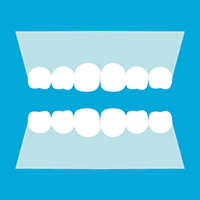
Cavity treatment
An implant is where an artificial tooth root (implant) is inserted where a tooth was removed. It is firmly fixed to the jaw bone, and then the artificial tooth is attached on top.
Compared to dentures, this is a revolutionary dental treatment that is more comfortable and which allows for chewing with the same force as natural teeth.
We also offer laser implants that involve no cutting or sewing, allowing you to undergo treatment in a short time and with little pain.
In conventional treatment, neighboring healthy teeth are scraped and used to create a bridge. However, having to scrape the healthy teeth feels like a waste.
In implant treatment, implants are inserted without scraping neighboring healthy teeth, and artificial teeth are attached. After treatment, you will not even be able to distinguish them from your real teeth.
In conventional treatment, several healthy teeth are scraped and made into bridges in order to support the greater chewing power of the two missing teeth. This means undue strain is put on the healthy teeth supporting the others.
With implants, an implant is inserted for each of the removed teeth. Since the implant is firmly fixed to the jaw bone, it allows for chewing with strong force.
In conventional treatment, removable dentures are made and bars are inserted on the left and right of the mouth to fix them into place. These can be further set into place with a stopper, but having a metal fixture in your mouth can be unpleasant.
In implant treatment, several implants are inserted and they are then connected to each other. With this solution, bars and stoppers to secure dentures are no longer needed, the inside of the mouth is cleaner, and bad breath is reduced.
In conventional treatment, dentures with a base attached to all of them are used. When the jaw bone recedes, these dentures tend to become unstable.
In implant treatment, several implants are placed and the dentures are fixed to a device used to maintain them aligned. Your dentures will be stable and won't move in your mouth or pop out when you laugh.
Implant treatment is recommended for those who with concerns like: "I don't want my teeth scraped unless it's directly related to dental treatment," "I want teeth that look similar to natural teeth," "I don't like having to put in and remove dentures," or "My dentures tend to move around in my mouth."
We encourage you to stop by for a consultation.
At Hanafusa Dental Clinic, we now offer "immediate implants after tooth extraction," where implants can be inserted on the same day the tooth is extracted. This reduces the number of clinic visits required, and greatly shortens the treatment period.
We will take X-rays and check the status of your teeth, explaining the situation to you.